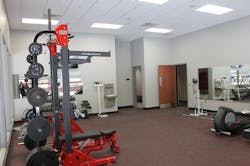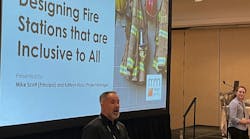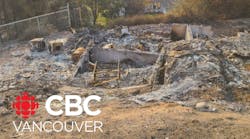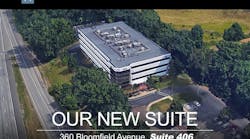Download the full PDF of the Station Design supplement here:
View Firehouse’s collection of supplements and special content at firehouse.com/special-content.
Does your fire department promote a training culture? Is safety and training foremost in the minds of your staff? Your officers? What about your elected officials?
A recent U.S. Fire Administration (USFA) publication “National Safety Culture Change Initiative," developed by the IAFC through a partnership with the USFA, presents a compelling case for a change in the culture of the nation’s fire departments, particularly as it relates to safety. This report was developed to explore reasons for, and how to respond to, the disproportionate number of losses in the fire industry relative to the decrease in the number of fires in the U.S. Seldom (if ever) does a week go by without news concerning an injury or death to an emergency responder, whether directly related to a line-of-duty event or a medical emergency stemming from a heart attack. Among numerous topics in this report, health, wellness and training are given significant emphasis. Many such incidents are avoidable, or at least their severity can be reduced, when a training program is implemented and, most importantly, embraced by the entire department.
The need for experience
A challenge to maintaining high-level firefighting skills is that the national reduction in the number of fire incidents over the years has resulted in fewer on-the-job training experiences. Of course, a downturn in the number of fire incidents is good, but it has resulted in a need to increase the level and opportunities for training, not only for new recruits, but for veteran firefighters as well. Repetition of basic firefighter training to maintain sharp motor skills and knowledge of existing techniques may be just as important as training on new tools and techniques. Training elements and equipment built into fire stations can enhance the training opportunities necessary to refresh and hone these skills.
Three major challenges face fire departments relative to training: 1) time constraints, 2) resource constraints and 3) leadership. Time constraints are perhaps most significant for volunteer departments as they struggle to find new recruits, but it is often noted as a challenge in career departments, too. Resource constraints (i.e., lack of funding) impact most departments in this time of reduced funding, staffing cutbacks and station closures. It is the final challenge—leadership—that can have the most profound influence in changing the culture of a department. The commitment to a training and safety culture must begin at the top of an organization and, with strong leadership, be filtered throughout the ranks of the department.
Department leadership can also influence the local officials who hold the purse strings. Making a strong case for funding training and safety initiatives is critical to gaining the necessary political will and funding to support an effective training program. This is critical when establishing a budget and seeking funding for a new fire station. Providing the infrastructure to support a training program in a new building project need not be expensive, and can potentially create a relatively quick return on investment. Basic training props can be incorporated for as little as 1 to 3 percent of the total building cost. One department reported the training tower and simple training props incorporated into their new headquarters station were essentially paid for within five years, given the savings in transportation and staff costs related to offsite technical rope rescue training that had previously been required.
Ideas for your “training fire station”
Over the past 15 years, fire departments around the country, along with their architects, have increasingly embraced the concept of the “training fire station.” These include small fire stations (10,000 square feet or smaller) to large fire headquarters. Training props incorporated into these stations range from simple floor openings to relatively complex training towers joined with training mezzanines and below-grade confined-space training. For relatively little cost, a mezzanine overlooking the apparatus bay provides a versatile platform on which basic ladder training, rappelling and confined-space props can be built. Openings placed in a wall, between the mezzanine and the bay floor below, provide basic ladder training, rescue training and ropes training. A simple opening in the mezzanine floor, utilizing removable steel bar grates or a standard manhole cover, provides an opportunity to train with a tripod. Careful placement of this opening over an alcove or similar space below provides a convenient opportunity for confined-space training. Careful consideration of the design and location of that space provides the ability to observe training—initial basic training with lights on, ultimately progressing to advanced training with lights off. Finally, the stairs required to access the mezzanine can be extended beyond the mezzanine to the roof level and above, transforming the stair into an essential training prop for hose advance drills, rappelling (both inside and outside the stairs) and high-angle rescue training. If the stairs are built with appropriate material for wet areas (including a dry standpipe with fire department connection and a valved pipe extension for sprinkler heads), it becomes a space to practice discharge hose and sprinkler head change-outs. As an added benefit, the roof access not only allows for easy access to any rooftop mechanical equipment, but also provides a roof area where additional parapet ladder training may occur.
These same props, if planned and incorporated carefully and imaginatively, can also be used to develop higher-level skills training. In this way, props used for repetitive skills training (ladder evolutions, technical rope techniques, hose deployment drills) can be expanded to create simulated scenarios incorporating critical decision-making into the training session. Firehouse Magazine Editor-in-Chief Tim Sendelbach has created and written about many training props that can be adapted and incorporated into a basic station design to augment the basic props described above. Consider the possibility of breaching a door, including a ceiling breach, advancing hose up a stair, connecting to a standpipe, then proceeding into a simulated bedroom on the mezzanine level, including a search and rescue complete with a rescue through the upper-level window accessed by a ladder.
Don’t discount the creativity of your department staff, especially your training officer, when developing concepts and designs for training props. Most of the solutions I have seen or participated in evolved from ideas generated in discussions with the firefighters themselves. Occasionally, with the creative juices flowing, ideas might exceed practical applications, yet brainstorming is often a productive exercise. A client once suggested a flood door at the basement level of his training stair that would allow him to flood the lower portion of the stair for water-rescue training. (He was a former Navy training officer.) The prohibitive cost of that idea eventually gave way to more important program requirements, but that volunteer department has remained to this day one of the more aggressively active training departments I have had the opportunity to work with.
Training and fitness rooms
In addition to training props, training rooms and fitness rooms are essential components of a fire station built to facilitate training. Many stations have been built where the added cost of these facilities are offset by making them available for other users. Consider making the training room available for outside groups. I remember one client who looked forward to the food (typically desserts) left for the staff after Scout or community group meetings. Training rooms as well as fitness rooms can also be made available for other city staff. However, remember that if outside users are permitted to use these facilities, it is important to design the station to permit direct access to these spaces without entering the private living and administrative areas of the station. A separate small locker room and toilet/shower is recommended for a fitness room shared by others, and public male/female restrooms must be considered for a publicly accessible training room.
Make the shift
A new fire station is an opportunity to support a cultural change related to safety in a department—or reinforce a safety culture that already exists. Providing effective training opportunities in the station design is a practical and effective way to make training more accessible, and with reduced time constraints on the department, ultimately saves costs, injuries and lives. A recent article addressing the decline of volunteer firefighters in one Northeastern state suggested that one reason for the decline is that volunteers spend 90 percent of their time fundraising. That leaves little time for training, and in a state where volunteer firefighter training may not be required, the safety of those who do volunteer is at risk. Training props built into the station and readily available for training scenarios, requiring little or no time for setup, are an invaluable asset to any new station design.
As Director of Public Facilities at KZF Design in Cincinnati, OH, Mark Shoemaker is responsible for leading KZF’s efforts in delivering professional architectural and engineering services for local government clients, including studies, design-bid-build and design-build projects. With more than 30 years of experience, Shoemaker has worked nearly exclusively on public projects, having completed more than 70 local government projects—administrative buildings, public works facilities and public safety facilities. He has a special interest in fire station design, and has completed more than 50 fire station projects around the country.






